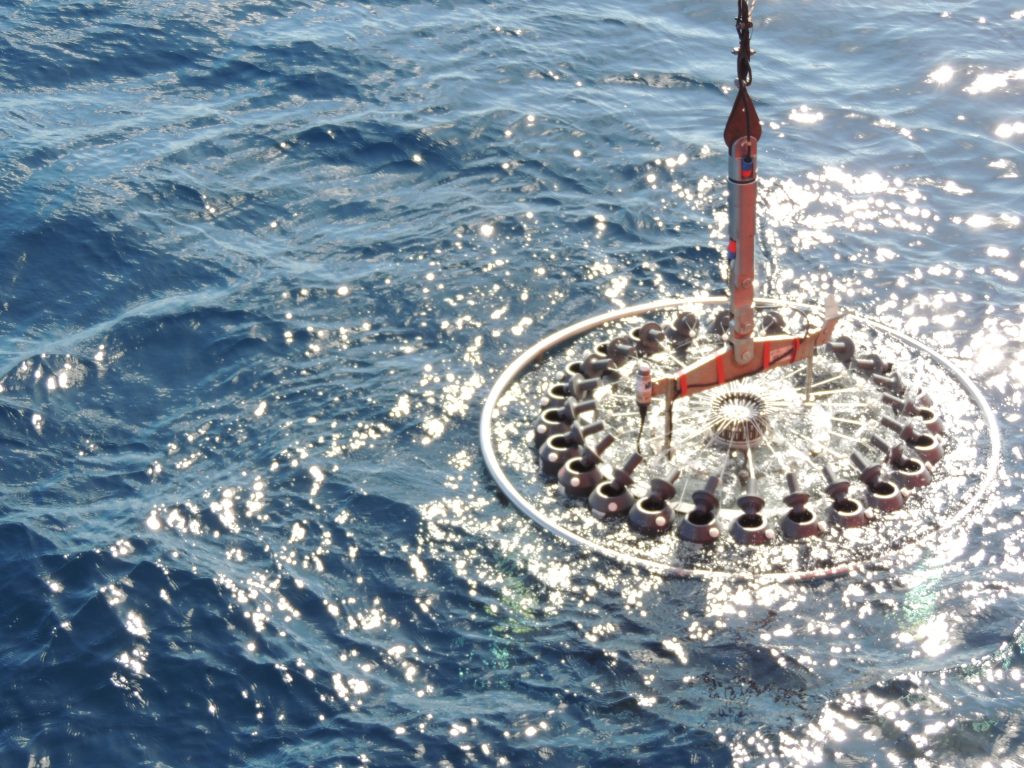With the AMT4SentinelFRM validation in full swing, Gavin Tilstone, from Plymouth Marine Laboratory, offers some insight into ocean biology. The objective of cruise is to validate ocean data from the fleet of Europe’s Sentinel-1, -2 and -3 satellites as they orbit above the Atlantic Ocean. These satellites, which were developed by ESA for the EC Copernicus programme, carry a range of sensors for observing land, ocean and atmosphere. The British Antarctic Survey ship, the Royal Research Ship James Clark Ross, set sail on 20 September 2016 on a voyage that traverses almost 13 000 km – starting in Immingham, UK, and ending in Stanley, the Falklands.
After crossing the equator we sampled a series of stations in the southern hemisphere to find out what is going on in the Southern Gyre. So what is a Gyre?
It is a swirling vortex, which in the ocean is created by wind or currents. There are two main gyres in the Atlantic Ocean that are created by currents: the Northern Gyre, which circulates clockwise and is created by the North Equatorial and North Atlantic currents, and the Southern Gyre which swirls anti-clockwise, created by the South Equatorial and Antarctic Circumpolar currents.

Conductivity, temperature and depth sampling in the sunlit blue waters of the Gyre. (PML)
The Southern Gyre can be clearly seen as the blue area in the image below, which represents very low Chlorophyll a. This area is demarked to the north and the south by the higher productive ‘green’ waters of the equatorial upwelling zone and the Southern Ocean.
Each of the Gyres has quite distinct biological, chemical and physical properties. The southern Gyre is more productive than the northern Gyre as it occupies a larger area and on average fixes 2.86Gt carbon per year as opposed to 1.12Gt carbon per year for the northern gyre.
The main phytoplankton group responsible for the fixation of carbon at depth is cyanobacteria, which are photosynthetic bacteria. It is arguably the most successful group of microorganisms on Earth and the most genetically diverse. Cyanobacteria live in a broad range of habitats across all latitudes, are widespread in freshwater, marine and terrestrial ecosystems, and are found in the most extreme niches such as hot springs, salt works, and hypersaline bays. The ability of cyanobacteria to carry out oxygenic photosynthesis is thought to have dramatically changed the climate and, therefore, the composition of life forms on Earth. Plants and eukaryotic algae all evolved from the cyanobacteria.

Chlorophyll-a median composites from 9–15 October 2016. (Thanks to Silvia Pardo for Satellite Imagery Support from NEODAAS).
The cyanobacteria species Synechococcus and Prochlorococcus occur in the Northern and Southern Gyres where they dominate the phytoplankton community. Prochlorococcus is generally more abundant in both, but the ratio between them can be altered in each of the gyres depending on the amount of grazing, light and nutrient limitation that they encounter.
In the Northern Gyre, which extends from approximately 38°N to 19°N, the mixed layer was at 40–60 m and the phytoplankton biomass reside at 100–125 m. At each individual station we sampled, the Northern Gyre seemed more productive than the Southern Gyre, and as a result of this we saw an abundance of wildlife at this location.
By contrast, in the Southern Gyre, the mixed layer and phytoplankton biomass have deepened to 90 and 130 meters, respectively. The water seems more oligotrophic and as a result, there is less phytoplankton biomass. To date, we have only seen small squid chasing minnow like flying fish.
Post from Gavin Tilstone, Plymouth Marine Laboratory
Message from ESA’s Craig Donlon: At sea measurements are the source of some of our greatest science when merged with satellite data and the AMT4SentinelFRM – being of Fiducial Reference quality – mean that we can really get to grips with some of the uncertainties in our measurements. I wish I was with you as I love being at sea and making new discoveries!
For more information: https://amt4sentinelfrm.org
Twitter follow: @AMT4SentinelFRM








Discussion: one comment
Instructive and sweet .tnx